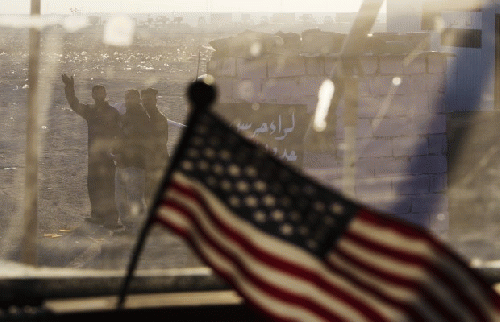Cross-posted from Paul Craig Roberts

Iraqis wave behind a US flag on the dashboard of a Mine Resistant Ambush Protected (MRAP) vehicle, part of the last US military convoy to leave Iraq on December 18, 2011 near Nasiriyah, Iraq.
(Image by LUCAS JACKSON-POOL/Getty Images) Details DMCA
George Herbert Walker Bush, a former Director of the Central Intelligence Agency who became President courtesy of being picked as Ronald Reagan's Vice President, was the last restrained US President. When Bush the First attacked Iraq it was a limited operation, the goal of which was to evict Saddam Hussein from his annexation of Kuwait.
Kuwait was once a part of Iraq, but a Western colonial power created new political boundaries, as the Soviet Communist Party did in Ukraine. Kuwait emerged from Iraq as a small, independent oil kingdom.
According to reports, Kuwait was drilling at an angle across the Iraq/Kuwait border into Iraqi oil fields. On July 25, 1990, Saddam Hussein, with Iraqi troops massed on the border with Kuwait, asked President George H. W. Bush's ambassador, April Glaspie, if the Bush administration had an opinion on the situation. Here is Ambassador Glaspie's reply:
"...'We have no opinion on your Arab-Arab conflicts, such as your dispute with Kuwait. Secretary [of State James] Baker has directed me to emphasize the instruction, first given to Iraq in the 1960's that the Kuwait issue is not associated with America.'"According to this transcript, Saddam Hussein is further assured by high US government officials that Washington does not stand in his way in reunifying Iraq and putting a halt to a gangster family's theft of Iraqi oil:
"At a Washington press conference called the next day, State Department spokesperson Margaret Tutweiler was asked by journalists:
"'Has the United States sent any type of diplomatic message to the Iraqis about putting 30,000 troops on the border with Kuwait? Has there been any type of protest communicated from the United States government?'
"to which she responded: 'I'm entirely unaware of any such protest.'
"On July 31st, two days before the Iraqi invasion [of Kuwait], John Kelly, Assistant Secretary of State for Near Eastern affairs, testified to Congress that the 'United States has no commitment to defend Kuwait and the U.S. has no intention of defending Kuwait if it is attacked by Iraq'."
(See here among other sources.)
Was this an intentional set-up of Saddam Hussein, or did the Iraqi takeover of Kuwait produce frantic calls from the Bush family's Middle Eastern business associates?
Whatever explains the dramatic, sudden, total change of position of the US government, the result produced military action that fell short of war on Iraq itself.
From 1990 until 2003 Iraq was acceptable to the US government.
Suddenly, in 2003 Iraq was no longer acceptable. We don't know why. We were told a passel of lies: Saddam Hussein had weapons of mass destruction that were a threat to America. The spectre of a "mushroom cloud over an American city" was raised by the National Security Advisor. The Secretary of State was sent to the UN with a collection of lies with which to build acceptance of US naked aggression against Iraq. The icing on the cake was the claim that Saddam Hussein's secular government "had al Qaeda connections," al Qaeda bearing the blame for 9/11.
As neither Congress nor the US media have any interest to know the reason for Washington's about face on Iraq, the "Iraq Threat" will remain a mystery for Americans.
But the consequences of Washington's destruction of the secular government of Saddam Hussein, a government that managed to hold Iraq together without the American-induced violence that has made the country a permanent war zone, has been ongoing years of violence on a level equal to, or in excess of, the violence associated with the US occupation of Iraq.
(Note: You can view every article as one long page if you sign up as an Advocate Member, or higher).





